7. Impulse-Response Analysis
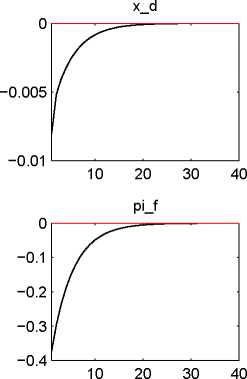
-0.2
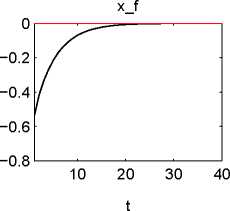
0
-0.1
-0.3
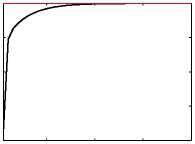
10 20 30 40
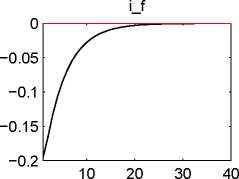
-0.4
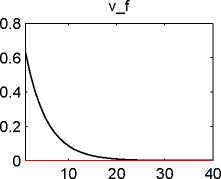
Figure 6: Responses to an impulse on the foreign monetary policy shock
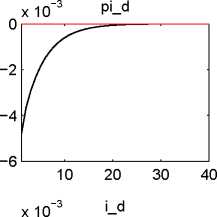
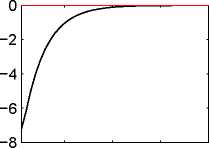
10 20 30 40
An interpretation of the results that can be derived from Figures 1 to 6 can be found in the following.
1. The domestic output gap, PPI inflation and nominal interest rates decrease before they return to
their zero-inflation steady-state values in response to an impulse on the domestic productivity shock
(Figure 1). The TOT first augment, then drop below their zero-inflation steady-state value until
they eventually converge. There is also an impact on all foreign endogenous variables, which is of
the same sign except for the foreign PPI and nominal interest rates. Nonetheless, this impact is
quantitatively small and induces fluctuations.
2. The foreign output gap, PPI inflation and nominal interest rates decrease before they return to
their zero-inflation steady-state values in response to an impulse on the foreign productivity shock
(Figure 2). The TOT first augment, then drop to their zero-inflation steady-state value. There is
also an impact on all domestic endogenous variables, which barely fluctuate. The impact is of the
same sign but quantitatively larger compared to the impact of the domestic productivity shock on
foreign variables. In addition, the US recovers notably faster from a shock on its own productivity
compared to the EU.
3. The domestic output gap decreases, yet the domestic PPI inflation and nominal interest rates in-
crease before all endogenous variables return to their zero-inflation steady-state values in response
to an impulse on the cost-push shocks (Figure 3). The TOT first plummet, then jump above their
zero-inflation steady-state value until they eventually converge. There is also an impact on all for-
eign endogenous variables, which is of the same sign except for the foreign PPI and nominal interest
rates.
4. The foreign output gap decreases, yet the foreign PPI inflation and nominal interest rates increase
before all endogenous variables return to their zero-inflation steady-state values in response to an
impulse on the cost-push shocks (Figure 4). The TOT first augment, then drop below their zero-
inflation steady-state value until they eventually converge. There is also an impact on all domestic
endogenous variables, which is of the same sign except for the foreign PPI and nominal interest rates.
25
More intriguing information
1. The name is absent2. Restructuring of industrial economies in countries in transition: Experience of Ukraine
3. The name is absent
4. Nonlinear Production, Abatement, Pollution and Materials Balance Reconsidered
5. The name is absent
6. The name is absent
7. The name is absent
8. Flatliners: Ideology and Rational Learning in the Diffusion of the Flat Tax
9. The Composition of Government Spending and the Real Exchange Rate
10. Telecommuting and environmental policy - lessons from the Ecommute program